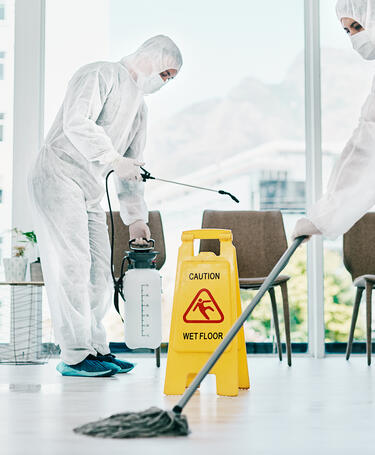
Preventing infectious disease hazards with ISO 45006

Richard Green provides an overview of the draft version of ISO 45006. The new Occupational health and safety management standard, that will provide organisations with guidelines for preventing and managing infectious disease hazards.
Introduction
Following the publication of ‘General guidelines for safe working during the COVID-19 pandemic’ in December, the intention was for TC283/WG5 to rewrite ISO/PAS 45005 as a more generic standard, ‘Safe working in a pandemic’. Instead, the decision was taken to create the new ISO 45006 -Occupational health and safety management – preventing and managing infectious diseases – General guidelines for organizations. This will sit alongside the existing PAS.
A preliminary draft was created at the end of 2020 and was circulated to WG5 members for comment by 4 March. This article is an overview of that draft.
The need for ISO 45006
Infectious disease hazards are increasingly recognised as major challenges to health, safety and wellbeing at work. ISO 45006 is a response to the risks in all workplace settings, including working at home.
By implementing the guidance in ISO 45006, organisations will be able to take effective action to protect workers and other relevant parties from the risks related to infectious diseases. They will demonstrate that they are addressing risks using a systematic approach and will evidence that they have established a framework to enable organisations to adapt to changing situations in an effective and timely manner.
This new standard provides good practical advice for those managing organisations as to how to structure their business to deal with disease-driven emergencies
Structure of the standard
The initial clauses of ISO 45006 mirror the structure of ISO 45001 – Context (clause 4), Leadership and worker participation (clause 5) and Planning (clause 6). It then becomes specific to the prevention and management of infectious diseases.
Clause 7 notes that the organisation should implement and maintain processes to support their workers’ psychological health and wellbeing during an outbreak, not just their physical wellbeing. This aspect is often overlooked in addressing the occupational health and safety of workers and was one of the principal drivers behind the development of ISO 45003.
Clause 8 requires sufficient resources to be provided to manage the risks associated with an outbreak. These range from infrastructure and environmental considerations to PPE, training and time off to attend medical appointments, such as vaccinations.
Clause 9 covers communications between the organisation, its workers and other relevant interested parties during an outbreak. It covers who should communicate, when they should, what should be communicated and how it should be done. It also sets out considerations for inclusion in communication processes, such as the use of visual signs and symbols and the need to consider appropriate points in time for communication. It also addresses communication associated with gaining entry into the workplace and the need for ongoing communication to workers as the outbreak progresses.
Clause 10 advises the organisation to establish and implement a hierarchy of controls to address the risks arising from incidents of infectious disease identified at the planning stage (clause 6). Ideally such risks should be eliminated, but if this is not possible, engineering considerations (ventilation, barriers) can be introduced. If this is not possible, administrative measures such as home working or physical distancing are suggested, with the last option in the hierarchy being the provision of PPE.
Clause 11 discusses possible controls for communicable diseases (a communicable disease is defined in the standard’s Terms and Definitions (clause 3) as ‘a contagious infectious disease transmitted from person to person’). These controls form the substantive part of this standard and encompass entering and leaving workplaces in areas with community transmissions, moving around and between workplaces under the control of the organisation, work zones and workstations, use of common areas, use of toilets, meetings and visits to workplaces, deliveries, working from home, working in other people’s homes, working in multiple locations, working with the public and work-related travel.
Clause 12 covers controls for non-communicable diseases. These are defined as ‘infectious diseases transmitted by exposure to sources in the environment’. The focus is on preventive maintenance checks of equipment and systems, such as those used for delivery of water supplies or air conditioning.
Clause 13 relates to endemic infectious diseases, and covers controls being applied in places where a worker works or needs to travel through to perform their job. The organisation is to notify workers of the need for vaccinations and any other advisory actions, such as preventing contact with insects or animals.
Clause 14 highlights the importance of personal hygiene, stressing basics such as handwashing, frequent cleaning and disinfection of work surfaces plus the appropriate disposal of used PPE.
Clause 15 promotes the use of masks and face coverings, protective gloves and protective clothing, while acknowledging the protection these offer against biological risks.
Clause 16 suggests the introduction and maintenance of processes to manage suspected or confirmed cases of an infectious disease. Actions are specified for both the organisation and for top management in respect of both the initial confirmation and risk assessment of the situation as well as the ongoing management of the situation through time. These encompass workplaces controlled by the organisation as well as the managing of illness of workers in other settings. ISO 45006 suggests these processes should cover screening, testing, contact tracing and quarantine.
Clause 17 deals with performance evaluation, and examines how effectively infectious diseases are prevented and managed by the organisation. It promotes the use of both proactive and reactive performance indicators, including the use of any national indicators identified in epidemic or pandemic situations. Management reviews are also advised, as is reporting to relevant external interested parties.
Clause 18 is about improvement and encourages the organisation to determine and develop its ability to manage the risks associated with infectious diseases.
Conclusion
This generic standard, based on ISO/PAS 45005 and applicable to all infectious diseases, is a valuable addition to the ever expanding ISO 45000 series.
At this time when the focus is very much on Covid-19, it is easy to forget that there are many other infectious diseases that will continue to be present post the current coronavirus battle. Even in its early incarnation, this new standard provides good practical advice for those managing organisations as to how to structure their business to deal with disease-driven emergencies. As the development of ISO 45006 continues, it will become a stronger and more rounded document.